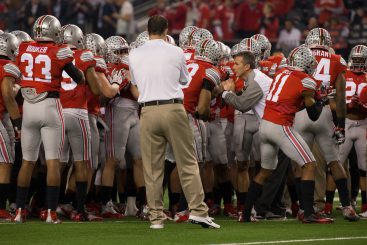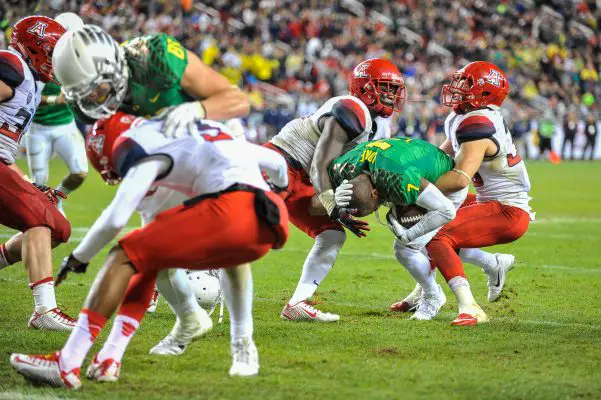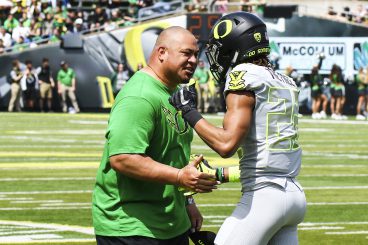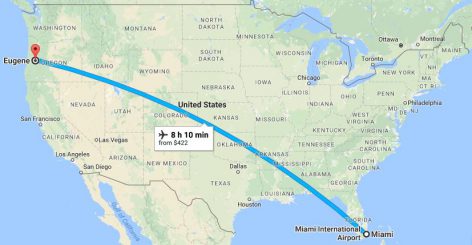Willie Taggart and Company’s recruiting success is impressive by any measure. But once you understand how the NCAA stacks the deck, Oregon’s 2018 class ranking becomes jaw dropping.
One of the reasons we love football so much is that there are clear rules about victory: the team with the most points wins. But even in athletic competition, the means of achieving victory do not always have such well-defined rules, and some leagues are more equally-governed than others.
For Oregon fans, Exhibit A that the NCAA plays favorites is an example from the 2014-2015 season. Leading up to the inaugural CFP National Championship game in January 2015, Ohio State was given more time to prepare for the game than our beloved Ducks.

Ohio State Head Coach Urban Meyer with his team.
As we reported then, the Ducks were limited to 20 hours a week of athletic activities, whereas Ohio State was allowed unlimited time to prepare. All this because the University of Oregon operates under the quarter system, while Ohio State University uses a semester schedule. Oregon fans were troubled not only because the NCAA could have employed a simple fix (either allowing Oregon unlimited time, or limiting Ohio State’s), but also because the disparity undercut the integrity of the competition.
What is Competition?
When it comes to athletic competition, we want both a clear definition of victory (the team with the most points wins) and rules fairly governing the means of achieving victory. Without both, sport cannot determine a true winner. But establishing rules that govern the means of victory raises a fundamental question about competition: which aspects of the game should be competitive, and which should be standardized by rules?
Xs and Os: Everyone understands that football requires rules on the field (e.g. you can’t hold a defender, or rush the quarterback before the ball is snapped). But outside the basic rules, we want the player-vs-player physical contest and the Xs and Os strategy to be part of a team’s potential competitive advantage. These aspects of the game are the essence of football competition.

Keanon Lowe had desire.
Talent Acquisition and Development: In a perfect world, team sports might involve standardized levels of athletic talent (at least in the acquisition phase). This would limit competitive advantage to innovative Xs and Os strategy and raw physicality. In fact, the NFL attempts to standardize talent levels by imposing a hard salary cap and conducting the draft in order to give talent-poor teams first pick of new players.
College football is a different beast entirely. The NCAA cannot standardize talent, particularly because college athletes are theoretically also students, and choosing a college is a very personal decision. Moreover, the NCAA cannot standardize the energy and likability of the coaches that make them effective recruiters.

Joe Salave’a sets the tone.
Most college football fans are no doubt satisfied with recruiting being part of the competition. After all, Taggart and Co. were hired, in part, for their recruiting prowess. But there is one aspect of recruiting that, ideally, would not deal an advantage to certain teams: geography.
Geography: The NCAA obviously cannot equalize the advantages and disadvantages of geography. High school football talent is concentrated along the eastern seaboard (especially in Florida and the rest of the South), Texas, and California. The Midwest, including Ohio, also has its fair share of talent. Put simply, some players like to stay near home, or play in major urban areas. There’s no way to change that. But the NCAA can and should avoid accentuating the recruiting advantage some teams have due to their geography.
Stacking the Deck
Within the NCAA recruiting bylaws are several regulations that appear to be neutral, but preference certain teams in effect. Perhaps the most egregious of these is the unofficial visit rule. There are two types of visits recruits can take: official and unofficial. On unofficial visits, recruits pay their own way, including travel to and from campus, as well as lodging and food while they are on campus. While teams have only a limited number of official visits they can offer athletes, unofficial visits are unlimited. For some teams, unofficial visits are a staple of their recruiting process, as athletes can easily reach their campus with minimal travel or cost (i.e. USC/UCLA, teams in Florida, and teams in Texas).

Miami to Eugene, not a quick trip.
But for recruits interested in the Ducks, unofficial visits can be expensive and time-consuming. Athletes from Florida, for instance, must buy an expensive cross-country plane ticket to Eugene and spend an entire day flying, with multiple connecting flights. That’s a massive disadvantage when a Florida recruit can more easily drive to the campus of their choice in Florida (University of Miami, University of Florida, and Florida State University all have Top-10 2018 classes so far this cycle), or a Los Angeles recruit can take the bus to USC or UCLA. Even the Utah Utes have a major airport hub in Salt Lake City.

Oregon’s weight room doesn’t mess around.
For teams in out of the way places that lack major airports such as Washington State, Boise State, Nevada, and Oregon, unofficial visits pose a remarkable disadvantage. For low-income recruits, unofficial visits to Eugene are simply not an option. For others who are on the bubble about Oregon, the prospect of shelling out the time and money for a cross-country flight might dissuade them from visiting what is one of the most impressive football facilities in the country.
Why?
Perhaps the NCAA has made a business decision in favor of teams in big media markets or near recruiting hotbeds (e.g. Los Angeles, Texas, SEC territory generally). The NCAA, while technically a non-profit, takes in nearly $1 billion a year. And it’s likely that having the best teams in major media markets is a big money-maker for the NCAA and its member conferences. But catering to those financial interests does not standardize the game in the way it should, or even produce the best and most compelling product on the field.
Regardless, Taggart and his staff understand that recruiting must be part of the competition of college football. Under Taggart’s direction, the Oregon Ducks will compete for recruits at an elite level despite Eugene’s geography and the NCAA’s accentuation of that disadvantage.
Taggart’s aggressive recruiting may be the missing piece in the Ducks’ winning formula, but fans of the game should want the NCAA to alter its unofficial visit rule to make talent acquisition more equitable.
Cody Lonning
Oakland, California
Top Photo From Video
Cody inherited all his sports allegiances from his grandfather, a long-time Eugene resident. Even though Cody graduated from law school at Berkeley, he remains a staunch Oregon fan. When he isn’t watching the Ducks, Cody is hiking, engaged in various home-improvement projects, or writing about politics. Cody grew up farming hay and wheat in Eastern Washington. Now, he practices law.

